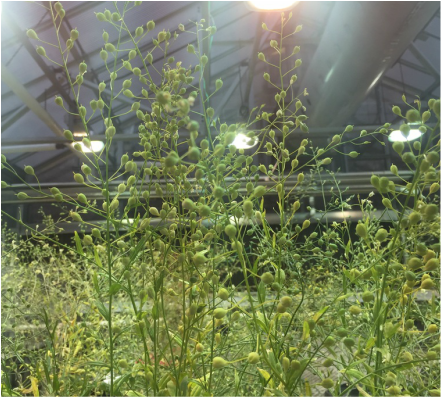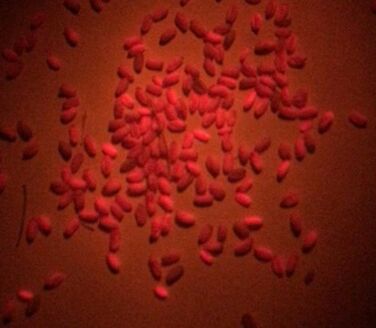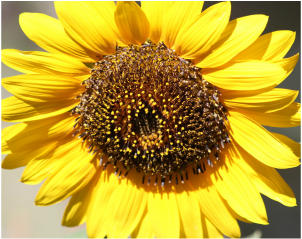Gold-of-Pleasure: the plant-based factoryPlants are incredible organisms with innumerable applications for advancing the human condition. Of course, we need plants to produce the oxygen that we breath, and the food we eat. However they posses many more facets that can be utilized for, well, saving the world. They can cleanse soils of salts and toxic heavy metals through a process known as bioremediation. Flowers and trees can be used in urban environments to simultaneously beautify, reduce pollution, attract pollinators, and provide food for animals (ourselves included).
|
As humans, we rely on chemistry to produce everything from pharmaceuticals to plastics. What many may fail to realize is that nature relies on factories too, in the form of plants and microbes. In fact, every organism is its own chemical factory producing metabolites for energy, and in many cases, secondary compounds for defense and volatiles for signaling. Plants are no exception, each producing a remarkable number of chemicals for survival and proliferation.

Plants can be manipulated in a variety of ways to produce more or less of the compounds that we, as humans, are interested in. We have long had this ability through artificial selection and domestication, and recently we've been able to make rapid, targeted changes to elicit desired outcomes. Genetic engineering has already produced crops that require less herbicide and insecticide, and others that are more nutritious; the future applications are incalculable. While we have already engineered yeast to produce compounds of interest, the process is intensive, requiring production in a laboratory setting. Furthermore, the yeast system is limited by its "primitive" metabolic pathways. Plants on the other hand have more complex enzymatic and metabolic networks which may be utilized to produce more specialized compounds. Camelina, in particular is well-suited to this for several reasons. Its close relationship to Arabidopsis means that much of the genetic and enzymatic architecture is easily elucidated from the extraordinarily well-studied model organism. Furthermore, Camelina can be readily transformed with exogenous genes that may be used to produce an almost endless number of compounds. The very short generation time of Camelina means that creation of stable transgenic lines can be done quickly. The high oil-content of Camelina is especially favorable for the production of lipid-based and lipid-soluble chemicals, which accumulate in the oil rich seeds. Collection and purification of chemicals of interest in these seeds offers a mass-production system for expensive pharmaceuticals and oils. Some of the most highly sought-after chemicals require expensive and complex multi-step synthesis in laboratories, often the case for efficacious cancer drugs. However, with the appropriate research and development, plants like Camelina may serve as plant-based chemical factories, bypassing the need for laboratory synthesis.
 Screening for successful Camelina transformants with DsRed as an indicator.
Screening for successful Camelina transformants with DsRed as an indicator.
How it works:
Similar to the most well studied plant model, Arabidopsis thaliana, relative ease of transformation in Camelina using the parasitic bacteria agrobacterium allows for traditional and CRISPR based modification of the genome. We generate genetic constructs containing promoters, terminators, selection genes, and genes of interest. Essentially, genetic constructs are the vehicles which drive "foreign" DNA into a target organism. They are typically circular pieces of DNA (i.e. plasmids) which are created or modified in the lab. Sometimes these contain only a single gene but can also contain multiple genes with different functions. The constructs also incorporate DNA sequences that facilitate cutting (restriction sites) which are used to temporarily break open the circular plasmid to insert new pieces of DNA. Promoters are short DNA sequences occurring before a gene sequence that allows their expression under various conditions. Promoter sequences are placed upstream of genes in a genetic construct and drive their expression in the host. For instance, in Camelina, we often use an oleosin promoter which expresses the gene of interest only in seeds. This can be useful for multiple reasons. Seeds of Camelina contain high levels of oil which can sequester volatile and oil-soluble compounds, allowing for increased compound stability and production. Also, gene expression exclusively in seed protects the rest of the plant from any adverse effects these compounds might have on plant growth and development prior to seed production. Moreover, seeds are the primary industrial product of Camelina, and thus if we want to produce a pharmaceutical compound or additional oils for biofuel, production in seed allows for bulk collection through the seed when the crop matures. Selection genes are essential to determine whether a transformation experiment was successful. There are many options available; however, we often use Red Fluorescent Protein (DsRed) which emits red fluorescence in seeds that have successfully integrated the construct into their genome. Thus, we can scan through our potential Camelina transformants and select those fluorescent red seeds which should also contain the gene(s) of interest included in the construct. Finally, genes of interest are any gene which a researcher wishes to express in a host for study or production of a specific product. For Camelina, these can be genes that code for enzymes which produce pharmaceutical drugs (Augustin et al. 2017), higher quantities of omega-3 fatty acids (Morineau et al., 2017), or even small aromatic compounds such as limonene and cadinene (Augustin et al. 2015). Utilization of biotechnology in Camelina has promising applications for its development as a plant factory which can produce high-value pharmaceuticals, industrial chemicals, and biofuels all while by-passing the need for resource intensive chemical synthesis. Furthermore, these techniques can be applied to producing higher yielding Camelina with traits such as drought and disease resistance.
Similar to the most well studied plant model, Arabidopsis thaliana, relative ease of transformation in Camelina using the parasitic bacteria agrobacterium allows for traditional and CRISPR based modification of the genome. We generate genetic constructs containing promoters, terminators, selection genes, and genes of interest. Essentially, genetic constructs are the vehicles which drive "foreign" DNA into a target organism. They are typically circular pieces of DNA (i.e. plasmids) which are created or modified in the lab. Sometimes these contain only a single gene but can also contain multiple genes with different functions. The constructs also incorporate DNA sequences that facilitate cutting (restriction sites) which are used to temporarily break open the circular plasmid to insert new pieces of DNA. Promoters are short DNA sequences occurring before a gene sequence that allows their expression under various conditions. Promoter sequences are placed upstream of genes in a genetic construct and drive their expression in the host. For instance, in Camelina, we often use an oleosin promoter which expresses the gene of interest only in seeds. This can be useful for multiple reasons. Seeds of Camelina contain high levels of oil which can sequester volatile and oil-soluble compounds, allowing for increased compound stability and production. Also, gene expression exclusively in seed protects the rest of the plant from any adverse effects these compounds might have on plant growth and development prior to seed production. Moreover, seeds are the primary industrial product of Camelina, and thus if we want to produce a pharmaceutical compound or additional oils for biofuel, production in seed allows for bulk collection through the seed when the crop matures. Selection genes are essential to determine whether a transformation experiment was successful. There are many options available; however, we often use Red Fluorescent Protein (DsRed) which emits red fluorescence in seeds that have successfully integrated the construct into their genome. Thus, we can scan through our potential Camelina transformants and select those fluorescent red seeds which should also contain the gene(s) of interest included in the construct. Finally, genes of interest are any gene which a researcher wishes to express in a host for study or production of a specific product. For Camelina, these can be genes that code for enzymes which produce pharmaceutical drugs (Augustin et al. 2017), higher quantities of omega-3 fatty acids (Morineau et al., 2017), or even small aromatic compounds such as limonene and cadinene (Augustin et al. 2015). Utilization of biotechnology in Camelina has promising applications for its development as a plant factory which can produce high-value pharmaceuticals, industrial chemicals, and biofuels all while by-passing the need for resource intensive chemical synthesis. Furthermore, these techniques can be applied to producing higher yielding Camelina with traits such as drought and disease resistance.
References:
Augustin JM, Higashi Y, Feng X, Kutchan TM. 2015. Production of mono- and sesquiterpenes in Camelina sativa oilseed. Planta 242(3): 693-708.
Augustin MM, Shukla AK, Starks CM, O'Neil-Johnson M, Han L, Holland CK, Kutchan TM. 2017. Biosynthesis of Veratrum californicum specialty chemicals in Camelina sativa seed. Plant Biotechnology Reports 11(1): 29-41.
Morineau C, Bellec Y, Tellier F, Gissot L, Kelemen Z, Nogué F, Faure JD. 2017. Selective gene dosage by CRISPR-Cas9 genome editing in hexaploid Camelina sativa. Plant Biotechnol J. 15, 729–739
Augustin JM, Higashi Y, Feng X, Kutchan TM. 2015. Production of mono- and sesquiterpenes in Camelina sativa oilseed. Planta 242(3): 693-708.
Augustin MM, Shukla AK, Starks CM, O'Neil-Johnson M, Han L, Holland CK, Kutchan TM. 2017. Biosynthesis of Veratrum californicum specialty chemicals in Camelina sativa seed. Plant Biotechnology Reports 11(1): 29-41.
Morineau C, Bellec Y, Tellier F, Gissot L, Kelemen Z, Nogué F, Faure JD. 2017. Selective gene dosage by CRISPR-Cas9 genome editing in hexaploid Camelina sativa. Plant Biotechnol J. 15, 729–739
